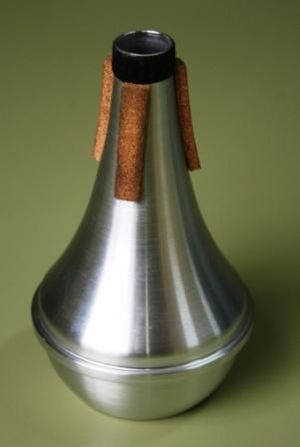Mute (instrument) facts for kids
A mute is a special device used with a musical instrument. It changes the sound of the instrument. Often, a mute makes the sound quieter. It can also change the tone or color of the sound. Mutes are used by musicians in many different types of music.

Contents
What is a Musical Mute?
A musical mute is an object that a musician places on or inside their instrument. Its main job is to change how the instrument sounds. Think of it like putting your hand over a speaker. The sound changes, right? A mute does something similar, but in a more controlled way.
Why Use a Mute?
Musicians use mutes for several reasons. One common reason is to make the instrument quieter. This is helpful for practicing, especially in a small space. Another big reason is to change the sound's quality. A mute can make a bright sound softer or give it a unique, muffled effect. This adds new sounds to a piece of music.
Changing the Sound's Character
Mutes can create many different sound effects. For example, a trumpet without a mute has a loud, clear sound. With a mute, it can sound buzzy, distant, or even like a human voice. These different sounds help musicians express feelings in their music. They can make a song sound mysterious, playful, or sad.
Mutes for Brass Instruments
Brass instruments, like the trumpet, trombone, French horn, and tuba, use mutes a lot. These mutes are usually placed inside the bell of the instrument. The bell is the wide, flared end where the sound comes out.
How Brass Mutes Work
Brass mutes work by blocking or changing the air flow. When a mute is in the bell, the sound waves have to travel around or through it. This makes the sound softer. It also changes the way the sound vibrates. This creates a different tone. Some mutes have holes or special shapes that let some sound out while still changing it.
Popular Brass Mutes
There are many kinds of mutes for brass instruments. Each one creates a unique sound.
- Straight Mute: This is a common mute. It makes the sound softer and a bit metallic. It's often used for a crisp, clear muted sound.
- Cup Mute: This mute has a cup-shaped end. It gives the instrument a softer, more muffled sound. It's often used in jazz music.
- Wah-Wah Mute (or Harmon Mute): This mute has a stem that can be moved in and out. Musicians can open and close the end with their hand. This creates a "wah-wah" sound, like a talking effect. It's very popular in jazz and big band music.
- Plunger Mute: This isn't a special mute you buy. It's often just a plunger from a sink! Musicians hold it over the bell and move it to create a "wah" sound. It's a very expressive mute.
- Practice Mute: These mutes are designed to make the instrument very quiet. They are perfect for practicing without disturbing others. They usually don't change the tone much, just the volume.
Mutes for String Instruments
String instruments, like the violin, viola, cello, and double bass, also use mutes. These mutes are different from brass mutes. They are usually small and clip onto the bridge of the instrument. The bridge is the small wooden piece that holds the strings up.
How String Mutes Work
String mutes work by adding weight to the bridge. When the strings vibrate, they make the bridge vibrate too. This vibration then passes to the body of the instrument, making the sound louder. When a mute is on the bridge, it stops some of these vibrations. This makes the sound softer and less bright. It gives the instrument a warmer, more mellow tone.
Types of String Mutes
String mutes are usually made of rubber, metal, or wood.
- Practice Mute: These are often heavy metal mutes. They make the instrument very quiet, great for practicing.
- Performance Mute: These are lighter mutes, often made of rubber. They soften the sound but still allow the instrument to be heard clearly. They are used when a composer wants a softer, more gentle sound.
Other Types of Mutes
While brass and string instruments use mutes most often, other instruments can also have them.
Piano Mutes
A piano can also have a "mute" function. This is usually controlled by a pedal. When you press the soft pedal (often the left pedal), it can shift the hammers or place a felt strip between the hammers and strings. This makes the sound quieter and softer. It's not a separate object you attach, but a built-in feature.
Drum Mutes
Drummers use mutes or dampeners to control the sound of their drums and cymbals. These can be rings placed on the drumhead, gel pads, or even blankets. They reduce the ringing sound and make the drums sound tighter or quieter.
When Mutes are Used
Mutes are used in many different types of music.
- Classical Music: Composers often write "con sordino" (with mute) or "senza sordino" (without mute) in their music. This tells the musician exactly when to use or remove the mute.
- Jazz Music: Mutes are very important in jazz. They help create unique sounds and effects. Jazz musicians often use wah-wah mutes and plungers to make their instruments "talk."
- Practice: Many musicians use practice mutes to play quietly at home. This is especially useful for loud instruments like the trumpet or cello.
Mutes are small but powerful tools. They give musicians more ways to create different sounds and express themselves through music.

